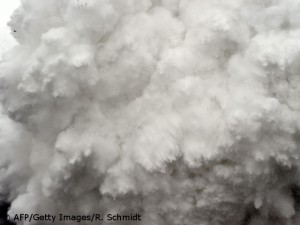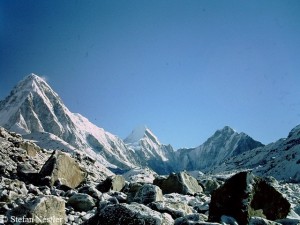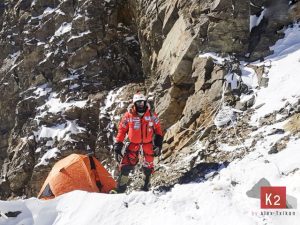Barely no chance to escape
The quite inconceivable really happened. A huge avalanche from Pumori, triggered by yesterday’s earthquake in Nepal, hit the Base Camp at the foot of Mount Everest at full force. The seven-thousander is located just opposite the highest mountain in the world. But hardly anyone had expected that an avalanche from Pumori would reach the edge of the Khumbu Icefall. “I ran and it just flattened me. I tried to get up and it flattened me again. I couldn’t breathe, I thought I was dead,” said George Foulsham, a mountaineer who lives in Singapore. The 38-year-old marine biologist was lucky and survived. It is not yet totally clear how many climbers lost their lives in Base Camp. An official of the Nepalese Ministry of Tourism said that so far 22 bodies have been recovered from the region around the highest mountain in the world: 17 directly from the Base Camp, five out of lower areas. About 200 people were still missing in the area.
Collapsed like a house of cards
Even further down the valley, Saturday’s earthquake has caused major damage. “Hardly a house that is still habitable,” writes the South Tyrolean journalist Walther Luecker from the 4371-meter-high village of Pheriche. “In the ruins, people are digging for their remaining belongings. Broken walls; roofs of corrugated iron collapsed like a house of cards; furnishing no longer in its place; frightened people wandering between the walls. And above their heads the helicopters, which bring new injured climbers.” In Pheriche, the Himalayan Rescue Association has been running a small clinic for many years. The injured from Base Camp were first flown there and to Lukla.
Aftershocks felt on the north side
On Monday, the helicopter rescue flights on Everest will resume. Then more climbers will be flown from the high camps above the Khumbu Icefall down to Base Camp. Today a strong aftershock of magnitude 6.7 on the Richter scale hit the Everest region – but this time without significant consequences. The shocks were also felt on the Tibetan north side of Mount Everest. “We were almost more shaken by the aftershock than by the main earthquake yesterday”, Ralf Dujmovits told me by satellite phone from the Intermediate Camp at 5700 meters. “But nothing happened. Sherpas told me that an avalanche hit the North Col after yesterday’s earthquake. No one was hurt.” When I informed Ralf about the latest casualty figures from Nepal, he only said: “Terrible!” The most successful German high altitude mountaineer wants to climb Everest without bottled oxygen this spring. The Chinese authorities requested all climbers to return to Base camp until the aftershocks stop. Also on Cho Oyu all mountain activities were forbidden.
Kathmandu airport opened again
There is little information from other regions of Nepal. In Pokhara, a city of about 250,000 inhabitants, the damage reportedly was significantly lower than in the capital Kathmandu. The center of Saturday’s earthquake measuring 7.8 was located between the two cities. Also from the nearby area around the eight-thousanders Annapurna, Dhaulagiri and Manaslu, there are only a few messages. This circumstance makes us hope that not too much has happened in the region. A representative of the environmental protection agency ACAP, which is issuing the permits for the Annapurna region, told the British broadcaster BBC, there were no reports of avalanches or stranded climbers and trekkers.
Kathmandu airport, which had been closed temporarily, was meanwhile re-opened. The death toll in Nepal has risen to over 2,500 (as of 19:00 CEST). It still aims, in particular, to rescue people in the earthquake area and to save as many lives as possible. As long as this situation persists nobody should discuss the issue whether the climbing season in Nepal will end prematurely – as it already did in 2014.
P.S. I receive more and more inquiries regarding people who were traveling in Nepal at the time of the earthquake. Please turn to the International Committee of the Red Cross (https://www.icrc.org/en) or to similar searches offered in Internet, for example https://google.org/personfinder/2015-nepal-earthquake.









